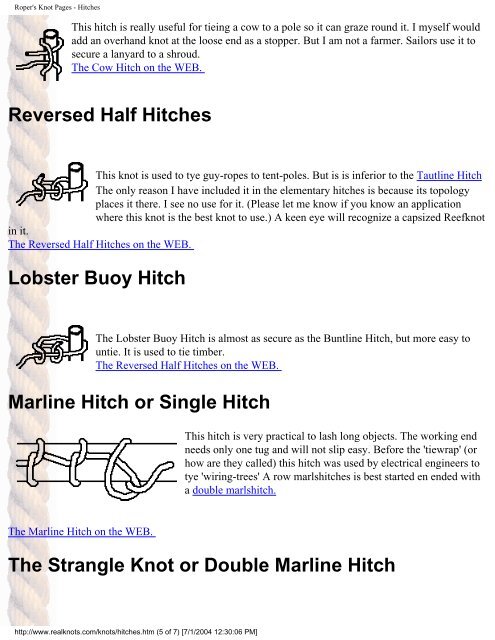Real Knots - Pole Shift Survival Information
Real Knots - Pole Shift Survival Information
Real Knots - Pole Shift Survival Information
Create successful ePaper yourself
Turn your PDF publications into a flip-book with our unique Google optimized e-Paper software.
Roper's Knot Pages - Hitches<br />
This hitch is really useful for tieing a cow to a pole so it can graze round it. I myself would<br />
add an overhand knot at the loose end as a stopper. But I am not a farmer. Sailors use it to<br />
secure a lanyard to a shroud.<br />
The Cow Hitch on the WEB.<br />
Reversed Half Hitches<br />
This knot is used to tye guy-ropes to tent-poles. But is is inferior to the Tautline Hitch<br />
The only reason I have included it in the elementary hitches is because its topology<br />
places it there. I see no use for it. (Please let me know if you know an application<br />
where this knot is the best knot to use.) A keen eye will recognize a capsized Reefknot<br />
in it.<br />
The Reversed Half Hitches on the WEB.<br />
Lobster Buoy Hitch<br />
The Lobster Buoy Hitch is almost as secure as the Buntline Hitch, but more easy to<br />
untie. It is used to tie timber.<br />
The Reversed Half Hitches on the WEB.<br />
Marline Hitch or Single Hitch<br />
This hitch is very practical to lash long objects. The working end<br />
needs only one tug and will not slip easy. Before the 'tiewrap' (or<br />
how are they called) this hitch was used by electrical engineers to<br />
tye 'wiring-trees' A row marlshitches is best started en ended with<br />
a double marlshitch.<br />
The Marline Hitch on the WEB.<br />
The Strangle Knot or Double Marline Hitch<br />
http://www.realknots.com/knots/hitches.htm (5 of 7) [7/1/2004 12:30:06 PM]

















